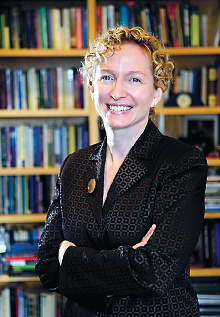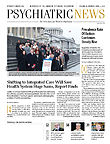Departmental chairs at academic medical centers have a unique leadership role within the institution as well as in the broader community—they speak with the authority of the institution; exert influence on teaching, research, and clinical practice; and often have visibility outside the institution that other faculty do not.
In this way, psychiatry department chairs can be instrumental in helping faculty, trainees, patients, and families understand advances in the field and navigate transitional milestones—such as the publication last May of DSM-5.
In a paper that appeared in Academic Psychiatry as one of six on the subject of DSM-5 and education, Laura Roberts, M.D., chair of the Department of Psychiatry at Stanford University, offered a department chair’s perspective on the opportunities and challenges inherent in the DSM-5 transition, especially in relation to what she identified as the five missions of a department chair: science, clinical innovation and service, education, community engagement, and leadership.
“The introduction of the fifth edition of the Diagnostic and Statistical Manual of Mental Disorders represents a major milestone for the medical and mental health professions in this decade,” she wrote. “Chairs, as leaders in medical schools, health systems, scientific institutes, the professions, and the public, with others will be responsible for the integration of DSM-5 in all of these domains. And chairs, when the time comes, will help develop and assure the rigor and utility of subsequent editions of DSM, simultaneously holding the past and working for the future.”
Department chairs were crucial in supporting the research that informed DSM-5 and will inform successive iterations of the manual. In her article, she stated that chairs “supporting the full portfolio of science, from basic to population, will facilitate the maturation of diagnosis in psychiatry, which, in turn, will help in the design, testing, and application of therapies that are more attuned to the underlying causes of illness.”
In comments to Psychiatric News, Roberts noted that several researchers at her own institution have been involved in research that has helped to refine criteria for mood and bipolar disorders, sleep disorders, and other diagnoses. She said she was not herself involved in developing DSM-5, but is helping to write and edit the DSM-5 Study Guide for American Psychiatric Publishing, with Alan Louie, M.D., director of education in Stanford’s Department of Psychiatry, and other faculty there.
The missions of science and clinical innovation may have been made slightly more confused, in some minds, by publicity surrounding the National Institute of Mental Health’s Research Domain Criteria (RDoC) project, which seeks to define basic dimensions of functioning (such as fear circuitry or working memory) and study them across multiple units of analysis, from genes to neural circuits to behaviors, cutting across disorders as traditionally defined.
Roberts commented that the two efforts can complement each other and that department chairs can be leaders in helping faculty, trainees, researchers, and the public understand why they do so.
“The intent of the RDoC and the DSM are so different,” she said. “Their frameworks focus on different levels, but they are compatible and can both bring perspective and insights to clinical medicine and underlying science. Department chairs have to serve as scientific leaders as well as clinical leaders and create a dialogue that allows faculty and trainees to move fluidly across the different frameworks in our multitheoretical and broadly empirical field. Leadership helps to create a language and a context that allows for great work to occur.”
Apart from research, department chairs are tasked with leading the education of aspiring psychiatrists. In Academic Psychiatry, Roberts said these psychiatrists will need to learn the deeper meaning of a diagnosis—beyond its utility as a label to encompass a cluster of symptoms. She wrote, “A key role for chairs is in elevating the understanding of learners regarding the therapeutic impact for a patient, and the family, of being given a diagnosis. . . .”
It’s a subject she says is addressed in depth in the forthcoming study guide. “If done thoughtfully and respectfully, in arriving at a diagnosis, the interaction between the clinician and patient can be a very positive experience,” she told Psychiatric News. “It can be an experience of being understood, an experience in which the patient does not feel isolated and alone in the experience of illness.
“Being given a diagnosis should not be framed as ‘bad news’ but should be seen as a part of the therapeutic experience,” Roberts said.
Roberts noted that in the time leading up to the publication of the new manual, many department chairs were called on by the media to explain the proposed changes in criteria.
“The controversies associated with certain diagnoses or diagnostic categories . . . figured prominently in major news outlets, and professional and advocacy organizations alike raised many difficult issues. . . . As leaders of the field of psychiatry, chairs are asked to articulate the reasons or at least the benefits of the new DSM.”
Roberts told Psychiatric News that she believes that DSM-5 is an “extraordinary effort” by scientists and clinicians around the world to characterize mental disorders through a shared framework and share language.
“It’s a tool to help people with diverse illnesses and conditions, and it is a tool to help clinicians, scientists, and students. As a document, it cannot fully capture the experience of living with mental illness, and it cannot substitute for thoughtfulness, compassion, and judgment.”
She believes that psychiatry department chairs can shoulder greater responsibility for making science meaningful and its applications more relevant and understandable. “To fulfill the public trust, academic institutions and academic leaders will help translate scholarship into social good,” she said. ■
An abstract of “
DSM-5 and the Five Missions Shouldered by Chairs of Psychiatry” can be accessed
here.


